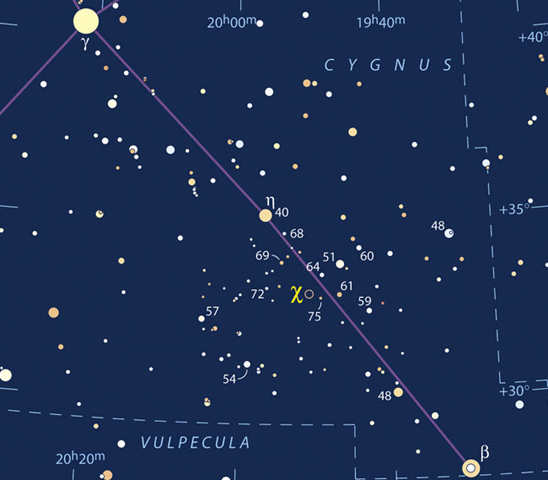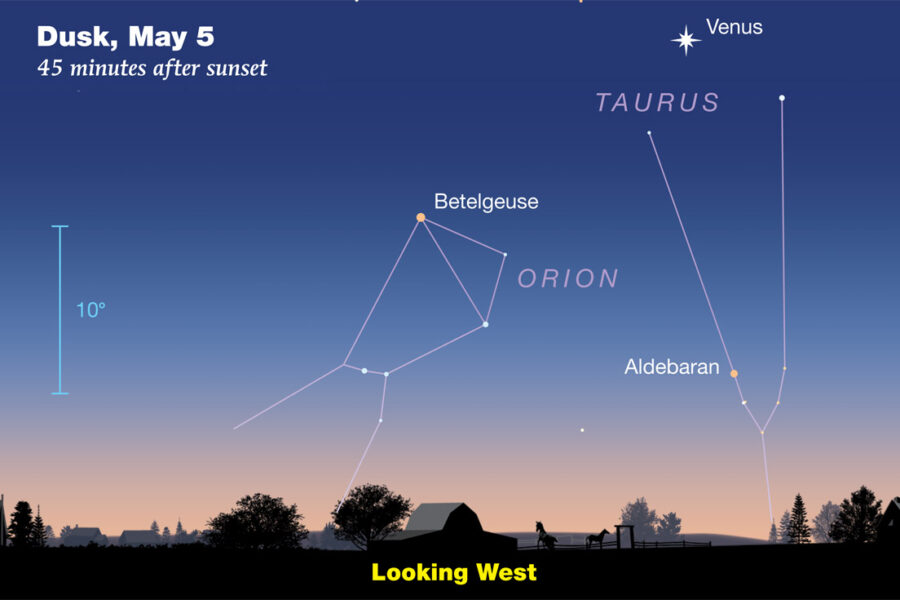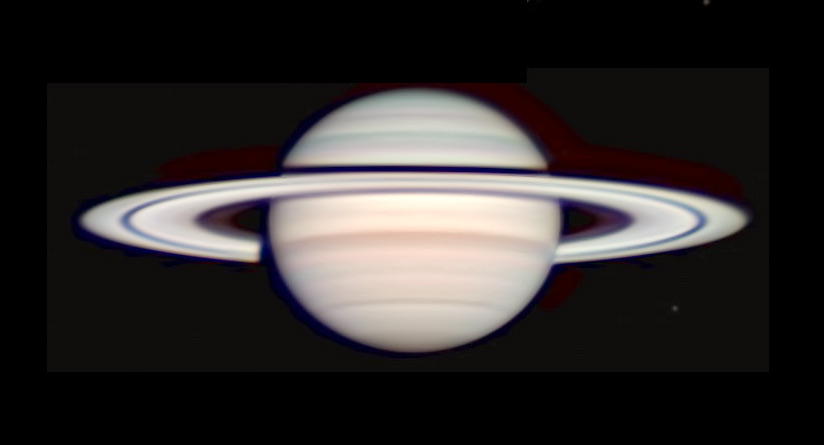FRIDAY, APRIL 28
■ The Moon, a day past first quarter, shines high toward the south-southwest after dark. It's hanging off the crook of Leo's Sickle. The Sickle is nearly upright, with its open side to the right.
SATURDAY, APRIL 29
■ Today is Spring Astronomy Day! Here are details and some local public events.
■ This evening the Moon, always a winner for public telescopic viewing, shines just behind (left of) the handle of Leo's Sickle.
The Moon is roughly equidistant from Regulus and Algieba, the Sickle's two brightest stars. Algieba is a nice telescopic binary at medium to high power: magnitudes 2.1 and 2.4, separation 2.7 arcseconds.
SUNDAY, APRIL 30
■ Face north just after nightfall, look very high, and you'll find the Pointers, the end stars of the Big Dipper's bowl, on the meridian pointing toward Polaris straight down below. From the Pointers to Polaris is about three fists at arm's length.
MONDAY, MAY 1
■ On this spirit-infused May Day evening (or so our ancestors believed), look high in the west for Pollux and Castor lined up more or less horizontally. Mars is a third, similar dot below Pollux.
Pollux and Castor form the top of the enormous Arch of Spring. To their lower left is Procyon, the left end of the Arch. Farther to their lower right is the other end, formed by 2nd-magnitude Menkalinan (Beta Aurigae) and then brilliant Capella.
Venus shines below the Arch's right side. And tonight, Venus lies smack between the horntip stars of Taurus to its right and left.
This whole big panorama sinks in the west through the evening.
TUESDAY, MAY 2
■ The waxing gibbous Moon tonight shines only a degree or two from 3rd-magnitude Gamma Virginis (Porrima) as seen from most of North America. Porrima is a lovely, equal-brightness double star for telescopes: separation 3.3 arcseconds this year, oriented almost north-south.
WEDNESDAY, MAY 3
■ Now the Moon poses only 2° or 3° from brighter Spica.
■ Arcturus shines high to the Moon's upper left. Turn northwest and look to the right of Venus (by about two fists) for Capella, essentially the equal of Arcturus. If you catch Arcturus and Capella just as the first stars come out, you'll find them standing at the same height above your horizon (depending a bit on your latitude).
■ And Vega, the Summer Star, the other zero-magnitude equal of Arcturus and Capella, twinkles low in the northeast at nightfall. . . depending on your latitude. The farther north you are the higher it will be. If you're in the latitudes of the southern US, you'll have to wait until a bit later after dark for it to appear.
THURSDAY, MAY 4
■ Chi Cygni, one of the brightest long-period red variable stars, should be at the brightest of its slow, 13-month cycle around now: probably 4th or 5th magnitude. Look for a new, faint star in the shaft of the Northern Cross. As shown below, Chi ( χ ) forms a long, isosceles triangle with 4.0-magnitude Eta ( η ) Cygni (the triangle's thin end, its northeast or upper left end) and a 5.1-magnitude comparison star 1° to Chi's northwest. The triangle points to Gamma ( γ ) Cygni, the center of the Northern Cross.

You can follow Chi's season of fading even farther through the summer and fall using the closeup comparison-star chart, with stars to much fainter magnitudes, in the May Sky & Telescope, page 49.
FRIDAY, MAY 5
■ Full Moon (exactly full 1:34 p.m. EDT). Look for the Moon rising in the east-southeast about 20 minutes after sunset. After dark it shines in the center of dim Libra, far below Arcturus and lower left of Spica.
Later in the night, watch for Delta Scorpii to rise about a fist to the Moon's lower left, then for Antares to rise less far to Delta's lower left.
Delta is still magnitude 1.7, about as bright as it has stayed since 2011 after brightening suddenly in 2000, then dipping up and down from 2005 to 2010. If anything, it has been showing a very slight, secular trend upward over the last two decades. When will it stop?
■ A deep penumbral eclipse of the Moon will be visible from eastern Europe, eastern Africa, almost all of Asia, and Australia. Mid-eclipse is at 17:23 May 5th UT. Map and details.
■ Venus remains at about the same height in the western twilight as it's been for a few weeks, but the horntip stars of Taurus behind it (Beta and fainter Zeta Tauri) are sliding farther below it every day.

SATURDAY, MAY 6
■ We're almost a week into May now, but wintry Sirius still twinkles low in the west-southwest in late twilight. It sets soon after. How much longer through the spring can you keep Sirius in view? In other words, what will be its date of "heliacal setting" as seen by you?
The farther south you live, the later in the season this will be.
SUNDAY, MAY 7
■ Summer is still more than seven weeks away, but the Summer Triangle is making its appearance in the east, one star after another. The first in view is bright Vega. It's already visible low in the northeast as twilight fades.
Next up is Deneb, lower left of Vega by two or three fists at arm's length. Deneb takes about an hour to appear after Vega does.
The third is Altair, which shows up far to their lower right after 11 or midnight.
This Week's Planet Roundup
Mercury is out of sight in conjunction with the Sun.
Venus (magnitude –4.2, in easternmost Taurus) is the brilliant "Evening Star" shining in the west during and after dusk. It doesn't set until two hours after complete dark.
Night by night, watch as the horntip stars of Taurus, Beta and fainter Zeta Tauri, slide down on either side of Venus. The planet shines a little below them at the beginning of the week, passes between them on Monday May 1st, then stands increasingly above them as they continue settling downward.
In a telescope Venus is a dazzling little gibbous globe, 66% sunlit and 17 arcseconds in diameter. It's gradually enlarging while waning in phase. It'll be 50% lit by late May and will be a bigger, dramatically waning crescent from mid-June through mid-July.
BTW, forget the Face on Mars. Now there's the Monkey on Venus. With 85,000 volcanos newly mapped on Venus, it had to happen. Wave hi to the monkey up there beyond the twilight.1
Mars is crossing Gemini this week, upper left of Venus by 2 or 2½ fists at arm's length. It's much closer below or lower right of Pollux.
Mars has faded to magnitude +1.3, the barest trace fainter than Pollux. Mars also shows a slightly deeper orange tint. It will line up with Pollux and Castor, to their left, on the evening of May 16th.
Mars is nearly on the far side of its orbit from us, so in a telescope it's just a tiny blob 5½ arcseconds wide.
Jupiter is lost in conjunction with the Sun.
Saturn (magnitude +1.0, in dim Aquarius) is low in the east-southeast before and during early dawn.

Go lives in the tropics at about latitude 10° north, so planets emerging from solar conjunction in the dawn sky gain altitude faster there after conjunction than they do for us at mid-northern latitudes. Go writes, "Saturn was around 30deg high. I had very good laminar flow [of high-altitude winds] which really helped the seeing."
Faint Uranus and Neptune are out of sight, very low in evening and morning twilight, respectively.
All descriptions that relate to your horizon — including the words up, down, right, and left — are written for the world's mid-northern latitudes. Descriptions and graphics that also depend on longitude (mainly Moon positions) are for North America.
Eastern Daylight Time (EDT) is Universal Time minus 4 hours. UT is sometimes called UTC, GMT, or Z time.
Want to become a better astronomer? Learn your way around the constellations. They're the key to locating everything fainter and deeper to hunt with binoculars or a telescope.
This is an outdoor nature hobby. For a more detailed constellation guide covering the whole evening sky, use the big monthly map in the center of each issue of Sky & Telescope, the essential magazine of astronomy.
Once you get a telescope, to put it to good use you'll need a much more detailed, large-scale sky atlas (set of charts). The basic standard is the Pocket Sky Atlas (in either the original or Jumbo Edition), which shows all stars to magnitude 7.6.

Next up is the larger and deeper Sky Atlas 2000.0, plotting stars to magnitude 8.5; nearly three times as many. The next up, once you know your way around, are the even larger Interstellarum atlas (stars to magnitude 9.5) or Uranometria 2000.0 (stars to mag 9.75). And be sure to read How to Use a Star Chart with a Telescope. It applies just as much to charts on your phone or tablet as to charts on paper.
You'll also want a good deep-sky guidebook. A beloved old classic is the three-volume Burnham's Celestial Handbook. An impressive more modern one is the big Night Sky Observer's Guide set (2+ volumes) by Kepple and Sanner.
Can a computerized telescope replace charts? Not for beginners, I don't think, and not on mounts and tripods that are less than top-quality mechanically. And as Terence Dickinson and Alan Dyer say in their Backyard Astronomer's Guide, "A full appreciation of the universe cannot come without developing the skills to find things in the sky and understanding how the sky works. This knowledge comes only by spending time under the stars with star maps in hand."
![]() Audio sky tour. Out under the evening sky with your
Audio sky tour. Out under the evening sky with your
earbuds in place, listen to Kelly Beatty's monthly
podcast tour of the heavens above. It's free.
"The dangers of not thinking clearly are much greater now than ever before. It's not that there's something new in our way of thinking, it's that credulous and confused thinking can be much more lethal in ways it was never before."
— Carl Sagan, 1996
"Facts are stubborn things."
— John Adams, 1770
1. Of course there's no monkey up there to say hi to, so don't write me about it! The Venus volcano photo is an example of pareidolia: overinterpretation of a sensory input to create the actual experience of seeing, for instance, faces, figures, and animals in clouds or tree trunks. Or stick-figure people and animals in the stars. Although these things are not actually real, the experiences of them are entirely real. Endless confusion in the world arises from people not grasping how fully both types of experience, the factual and the creative, arise from our exact same neural process of reality-determination and consciousness formation -- just with a different balance of priors versus inputs. See the beholder's share in art theory (such as for how impressionism works). For the currently favored neural algorithm responsible for the formation of all conscious perceptions and ideas, real or hallucinated, see Bayesian brain. Recent developments; see the second section, second through 8th paragraphs.
End of Consciousness Mechanism 101. Go skywatch, and say hi to your pareidoliated monkey who isn't there but is.
 6
6









Comments
mary beth
May 1, 2023 at 6:09 pm
Thanks again for making sure this got posted Monica Young! I always feel like this week is the start of wonderful summer stargazing! Love your description of May Day!
You must be logged in to post a comment.
Rod
May 3, 2023 at 6:55 am
Hopefully you are enjoying better stargazing nights than I am 🙂 Not good since 23-April observations. Clouds and rain, more clouds and light rain. Pasture mowing and weed whacking more too 🙂
You must be logged in to post a comment.
mary beth
May 3, 2023 at 6:33 pm
Sorry to hear that Rod. I hope things clear off soon. We’ve had a mixed bag - some nights are clear, and some are cloudy. Last night was absolutely beautiful with the waxing gibbous moon by Porrima, and I think tonight will be too. Tomorrow is my birthday, so we are celebrating early with ribeye steaks tonight, and stargazing with neighbors. One of them brought over a beautiful chocolate mousse cake!
Going to try to note the time when Arcturus and Capella are about the same declination. I think the summer triangle will be fully visible almost exactly at midnight, just in time for the Solar Summer (which starts May 7, per Accuweather).
May the Fourth be with you!
You must be logged in to post a comment.
Rod
May 4, 2023 at 7:39 am
Very nice, enjoy your b-day 🙂 tonight for me, mostly cloudy and perhaps some scattered showers too. 🙂
You must be logged in to post a comment.
mary beth
May 4, 2023 at 1:09 pm
Thank you, Rod! I’ll eat an extra piece of cake for you lol.
So glad you had a nice morning for viewing the sun spots and that you have all the equipment for safely doing so. Very interesting!
You must be logged in to post a comment.
Rod
May 4, 2023 at 9:50 am
I was able to enjoy some solar observing this morning before more cumulus clouds began rolling in.
Observed 0830-0915 EDT, sunrise 0606 EDT. The Sun in Aries this morning. "Sunspot AR3293 has a 'delta-class' magnetic field that harbors energy for strong M-class solar flares. Credit: SDO/HMI REVERSED POLARITY SUNSPOT: New sunspot AR3296 is breaking the law. Hale’s Law, that is. The sunspot's magnetic field is flipped compared to other nearby sunspots in the sun's northern hemisphere. This magnetogram from NASA's Solar Dynamics explains the situation: According to Hale's Law, Solar Cycle 25 sunspots in the sun’s northern hemisphere should have a -/+ polarity. That’s negative on the left, positive on the right. However, AR3296 is the opposite; its polarity is reversed. Studies show that about 3% of all sunspots violate Hale’s Law. In most ways, reversed polarity sunspots are totally normal. They have the same lifespan and size as ordinary sunspots. In one important way, however, they are different. According to a 1982 survey by Frances Tang of the Big Bear Solar Observatory, reversed polarity sunspots are more than twice as likely to develop complex magnetic fields, in which + and – are mixed together. Reversed polarity sunspots are therefore more likely to explode. Solar flare alerts: SMS Text.", ref spaceweather.com.
I viewed all 8 active region sunspots reported this morning by spaceweather.com. Quite a view now. I used TeleVue 40-mm plossl for 40x and TeleVue 32-mm plossl for 31x observations, including at times #23A red filter. Plage very apparent at many sunspots active regions this morning. The Sun's angular size according to Stellarium 23.1 1903 arcsecond or 31.715 arcminute. True FOV at 31x ~ 96 arcminute. At 31x, ~ 9.6 arcsecond resolution on the Sun ~ 7.0183E+03 or 7018 km diameter. Earth size on the Sun ~ 17.5 arcsecond. Some of the active region sunspots this morning larger than Earth size like AR3296.
You must be logged in to post a comment.
You must be logged in to post a comment.